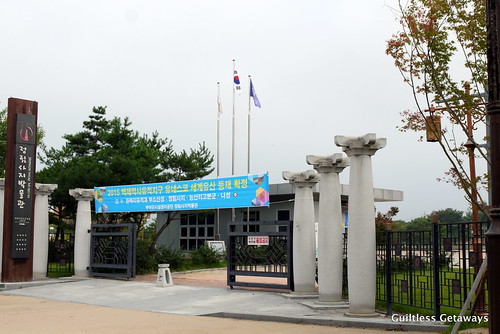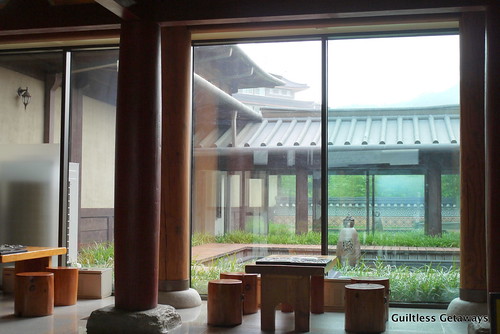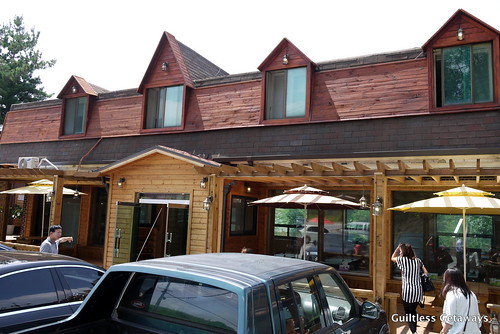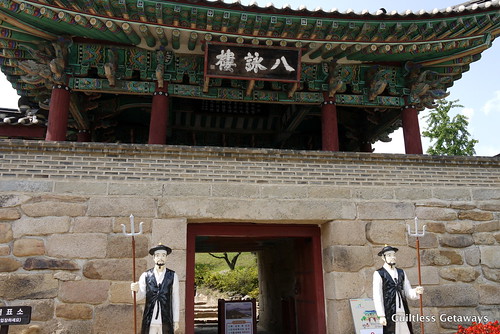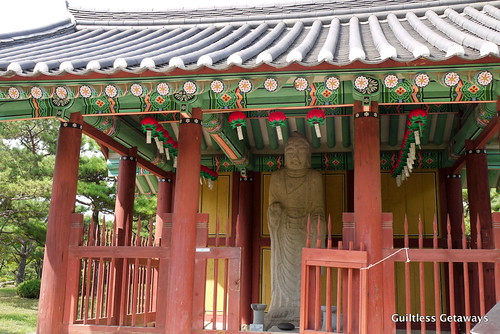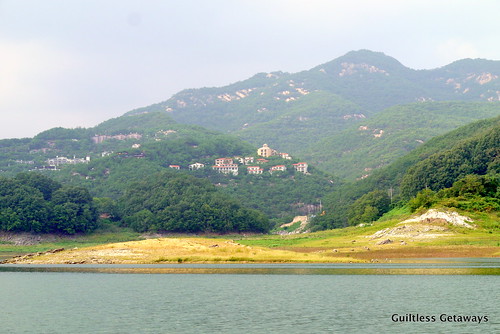Our last day in the Southern Chungcheong Province ended with a trip to Jeongnamsaji. The Baekje Historic Area was recently inscribed on the UNESCO world heritage list just this May 2015! Our group then travelled all the way to the Northern Chungcheong Province after for 4 hours (with a lunch stop) and we took in the scenic route through a ferry ride in Chungju Lake.

Part of the inscribed UNESCO cultural property site includes eight archaeological sites that represent the Baekje Kingdom. The Jeongnim-sa (temple) is one of them (it opens at 9 a.m.) and it's just 10 minutes away from the Lotte Buyeo Resort.

In the Jeongnimsaji Museum, we were briefed on the spread of Buddhism, construction techniques, excavation relics and close trade relations between Korea, China and Japan in the ancient kingdom.
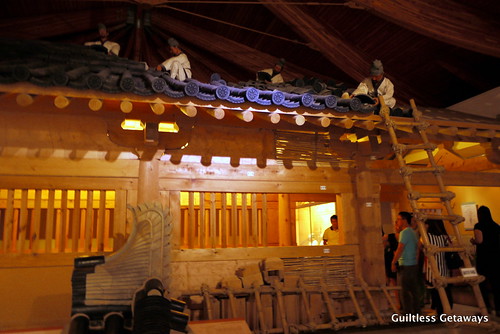
This birch tree table is an example of something that was produced in this area during the Baekje Dynasty and delivered to Japan. Our guide pointed out that Japan has many wooden pagodas made by the same Baekje people and still remain today.

Meanwhile, Buddhism found its way to Korea from China. According to our guide, religion used to be Buddhism during that period and has been reduced to around 25% nowadays.
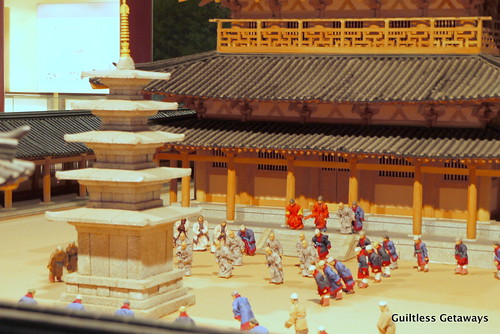
There were 2 other kingdoms aside from Baekje fighting for land and power during that time - Silla and Goguryeo. This temple was invaded by Mongolians (with Silla Kingdom forming an alliance with the Tang Dynasty in China to unify the 3 kingdoms) in the 7th century.

They've reconstructed the hall at the back. At first thought, I hoped that they can build it up more and restore the area but they've made it in such a way that highlights how the stone pagoda was able to withstand the test of time with everything around it constantly changing.

It has been designated as a National Treasure - perhaps not only for its historical and cultural significance but also for the architectural reasons, esp. on the precision on how it was built. For more info on the Jeongnimsa Temple site, click here.

There are also Chinese inscriptions, which is a story in itself because a lot of people thought that the Chinese built it (according to the guide) but we can only take in clues and discern for ourselves since this happened centuries ago. This 5-storey stone pagoda was once called Pyeongjetap. Check out the story of General Su Dingfang here.

This is dduk galbi or galbi burger steak for short hehe. It's a Korean style beef patty traditionally made with walnuts and rice flour. I initially thought that it's rice cakes because it's called the "dduk" but I've read somewhere that it's called "rice cake ribs" because it's made using the palm of the hand to pound the meat like when they make rice cake.

We got to Chungcheongbuk-do at last by around 2 p.m.! Our schedule was a bit tight and we missed our original ferry time so we went in to explore the nearby Cheongpung Cultural Heritage Complex for a while. When the Chungju Dam was completed, the traditional buildings and houses in Cheongpung were relocated here while the village was submerged with the creation of the Chungjuho (lake).

The complex is at the "foot of Mt. Mangwolsan". I wish I had more time here - it was breezy and fresh air seemed to surround me. If we had free time, I would have looked for the Yeollimok (trunks are connected) or Yeolliji (branches are together) trees or what they call "love trees" or 사랑나무 just because they've been growing together for so long and become one.
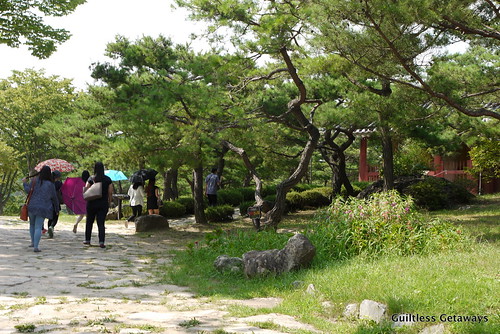
I would have said hello to the Buddha and stayed around for a bit. This post here tells about bowing and turning the stone according to your age.

Read more about the Cheongpung Cultural Properties here. In mid-April, the Cheongpung Cherry Blossom Festival also happens in this area if you're up for a scenic 10 km riverside drive. There's the Cheongpung Lake monorail somewhere in the Jecheon area also, they said.

The best time, I've heard a lot of times, is to visit Chungju Lake in autumn. It's a multi-purpose lake that even has bungee jumping for water sports enthusiasts.

I believe we came from the Cheongpungnaru Stop. A little bit of caution though for the dock. It really requires some physical strength to go up and down this steep path. We passed by lots of grannies though as we made our way back up (us being out of breath and them taking their sweet time).

I can only imagine the mountains blanketed in red, yellow and green right now... The local guide I talked to said that there's a popular hiking trek in this area for those who have a day or two to spend. This area is known for Mt. Woraksan National Park.

You can catch the designated eight most beautiful sceneries of Danyang somewhere along this route and it's better if you have a local guide to point it out. Our boat reached Sindanyang ferry port where others alighted then we turned around to our original port. No English here so it's better to have a local with you.

I think that's our Club ES Resort in a distance! Haha. Anyway, there are lots of resorts in the area.

This trip was made possible by Asiana Airlines Philippines, Korea Tourism Organization Manila, USTravel, Korea Tourism Organization Daejeon Chungcheongnam-do Promotion Office, Korea Tourism Organization Sejong Chungcheongbuk-do Promotion Office, the Chungnam Tourism Industry and both the Chungcheongnam-do and Chungcheongbuk-do Provincial Government. Korea is now MERS-free according to KTO and I just went there this August 2015.
Asiana Airlines flies once daily from Manila to Busan or Seoul and vice versa. You can book through your favorite local travel agencies about this tour. Chungnam and Chungbuk may be reached via Korail.
Jeongnimsa Temple Site in Chungnam, 황금똑갈비 Ddukgalbi Lunch, Cheongpung Cultural Heritage Complex in Jecheon and Chungju Lake Cruise in Chungbuk!
Details:
Cheongpung Cultural Heritage Park 정풍문화재단지
2048, Cheongpungho-ro, Cheongpung-myeon, Jecheon-si, Chungcheongbuk-do
How to go from Seoul
황금똑갈비 Ddukgalbi
중북 제전시 정풍면 북진리 317 번지
010-7154-3769 / 0101-4032-4769
Chungjuho Lake Ferries - borders Chungju, Jecheon, Danyang
Schedule, Booking and Information
Details:
Cheongpung Cultural Heritage Park 정풍문화재단지
2048, Cheongpungho-ro, Cheongpung-myeon, Jecheon-si, Chungcheongbuk-do
How to go from Seoul
황금똑갈비 Ddukgalbi
중북 제전시 정풍면 북진리 317 번지
010-7154-3769 / 0101-4032-4769
Chungjuho Lake Ferries - borders Chungju, Jecheon, Danyang
Schedule, Booking and Information
